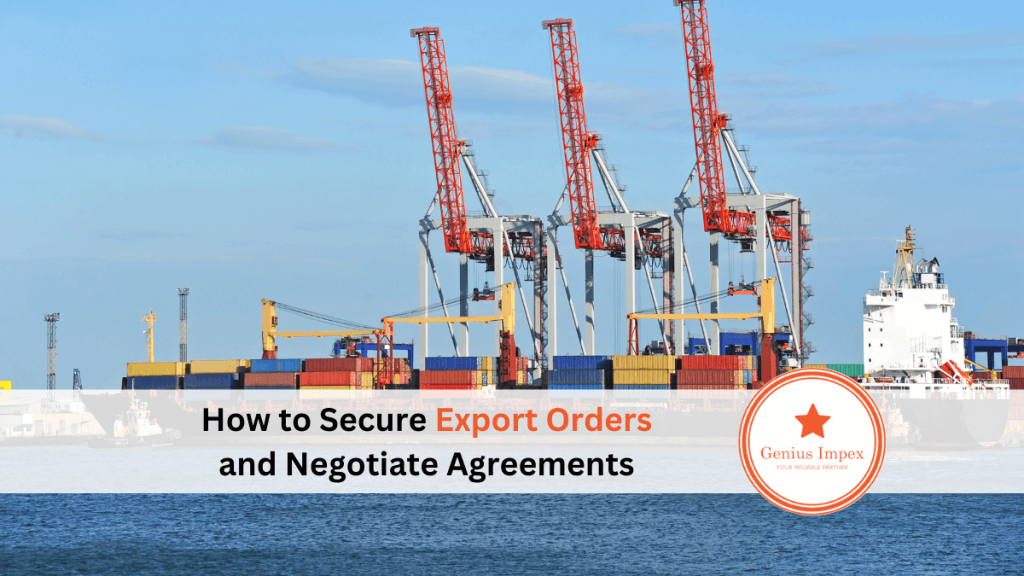In today’s globalized economy, international trade is essential for businesses to expand their reach, increase revenue and grow their brand. However, with the benefits of exporting come significant risks, including uncertainty, cultural differences, and legal complexity. Securing an export order and negotiating an agreement that satisfies both parties requires a deep understanding of the market, effective communication skills, and the ability to negotiate legal terms.
To effectively engage in international trade, businesses must have a robust strategy for managing risks and maximizing opportunities. In this blog post, we will provide insights on securing export orders and negotiating agreements effectively.
We will cover topics such as identifying potential customers, conducting market research, developing pricing strategies, managing risks, and negotiating terms with foreign buyers.
Furthermore, we will examine tools and frameworks to help you mitigate risks, develop strong business relationships, and achieve long-term success in the global market.
Secure Export Order and Negotiate Agreement
Let’s learn how to secure export order and negotiate a contract with potential buyers.
1. Research the target market and customer’s requirements
The first step to securing an export order and negotiating a successful agreement is conducting thorough research on the target market and the customer’s requirements. It involves analyzing market trends, competition, and customer demographics to identify potential buyers‘ needs, preferences, and expectations.
The information gathered can help you tailor your product or service to meet the specific requirements and preferences of the target market and differentiate yourself from competitors. Besides, it is crucial to understand the cultural nuances of the target market and adapt your approach accordingly.
By prioritizing thorough research, you can ensure that your export order aligns with customer expectations, ultimately increasing your chances of securing long-term partnerships and success in the international market.
2. Prepare a competitive and attractive quotation
Every business transaction starts with a query, a product inquiry, or a quotation request. It’s important to show each inquiry the attention it deserves and evaluate the factors before quoting a price. It requires a thorough examination of multiple aspects, such as:
- What price should you charge to remain competitive?
- While calculating prices, you should calculate all costs, including packing, insurance, credit, import-export agent’s commission, octroi duties (Octroi charges are imposed by state administrations when a product enters the state. It is a charge for allowing the transit of goods through the jurisdiction. Any Octroi charges asked by the Courier company are payable by the Customer.), documentation fee, marking charges (The purpose of marking on the exported goods is to specify cargo for destination and origin. Leading & Subsidiary Marks are two types of markings.), transportation charges, and export duties.
- To secure a good price, you should research the price of the same product in the international market. If there is a good markup in price, use the gap to your benefit.
Quote serves as a Performa invoice
In international trade, a quotation functions as a Proforma Invoice, providing valuable support to prospective buyers to secure financing, open a letter of credit, and obtain the required import license. This document outlines the key details including, but not limited to:
- The buyer and seller in this trade.
- A detailed description of the goods.
- The HS code of those goods.
- The price quoted.
- The payment term of the export order is according to the current incoterms.
- Complete delivery details, including mode, destination, and delivery cost.
- Agreed currency is mentioned in the quote.
- Add a proper date in your proforma invoice and include an expiration date. There can be a lot of technicality in the export process, so minimize your risk in the import-export business by setting a specific time frame for your quote.
Moreover, an easy-to-understand and professional format will enhance the credibility of your quotation and demonstrate your commitment to quality.
3. Make use of negotiation techniques to reach a favorable agreement
When securing an export order and negotiating an agreement, companies must be prepared to use negotiation techniques to reach a favorable outcome. It can include strategies such as preparing a detailed list of negotiation objectives, researching the target market and understanding local regulations, being flexible and willing to compromise, and effectively communicating and building relationships with potential buyers.
It is important to consider the agreement’s risks and benefits and thoroughly understand the terms and conditions involved. By taking a strategic and informed approach to negotiations, companies can successfully secure an export order and establish a long-term partnership with their buyers.
4. Ensure a few things to secure the export order
- Verify the import license of the buyer, company registration documents, and any other docs required for vendor registration and authentication. Proforma invoices are mostly checked before finalizing any agreement.
- Send samples to the potential buyer or get detailed specifications of the demanded product.
- Some certification or third-party inspections may also be needed depending on the customer’s demand. Ensure that the final product meets the specifications agreed upon initially.
- In case of no advance payment, ensure that you are dealing with a genuine buyer and that the payment will be received without hassle once the order is delivered.
- After a complete understanding of the required order, if the deal is confirmed against the price quotation, a ‘proforma invoice’ is generated, which lists all the order details, the quoted price on CIF or FOB basis, and the delivery terms. Proforma invoices can also be used to open L.C.
- Obtain the following import-export documents as per the requirement of buyers: Specific Product related certificates, if any, Certificate of Origin, i.e., Preferential or Non-preferential, E-form, Commercial Invoice, Packing List, Goods Declaration (G.D.), etc.
- Obtain Fumigation Certificate & Phytosanitary Certificates if required.
5. Understand the financial risks associated with export order
Understanding the financial risks associated with such orders is crucial when securing export orders and negotiating agreements. Before entering into any contractual agreement with a buyer, conducting extensive research on the company’s financial stability, creditworthiness, and reputation is essential.
Payment terms, currency, and payment methods should be negotiated to reduce the risk of default and exchange losses. Insurance against political and commercial risks should also be obtained to protect against unforeseeable events that may impact the export order.
The agreement’s clear and concise payment terms, and conditions will ensure understanding and avoid disputes. Understanding and mitigating the financial risks associated with export orders ensures that your business is well-protected and profitable.
6. Negotiate terms and conditions of the contract
The agreement’s terms and conditions depend upon the type of exported goods. It is customary for buyers to take measures to guarantee that the quality and quantity of the products delivered adhere to the necessary specifications. Contrarily, the exporter must ensure timely payment upon shipment delivery.
While it is common practice for goods to be exported following the terms outlined in a proforma invoice, it is recommended that exporters employ written and legally binding export contracts. These contracts should include the fundamental components of an export agreement, such as:
- Names and addresses of the importer and exporter.
- Goods, standards, and specifications.
- Units of measure in both figures and words.
- The total contract value in words, figures, and a specific currency.
- Delivery terms, based on the Incoterms.
- Terms of payment: Amount, mode, and currency.
- Inspection: State the nature, manner, and focus of the inspection, as well as the inspection agency. Many goods are now subject to pre-shipment inspection by designated agencies, and international buyers may specify their inspection agencies and conditions for inspection.
- Requirements of documents for international trade transactions.
- Delay in delivery: Damages due to the importer from the exporter in the event of late delivery owing to reasons other than force majeure.
- A contract should provide for the insurance of goods against loss, damage, or destruction during transportation.
- Force majeure: Conditions in the contract specifying possibilities that would clear partners of their liability for non-performance of the contract.
- Applicable law: The country’s law that governs the contract.
- Arbitration clause to facilitate friendly and quick settlement of conflicts or differences between the importer and exporter.
7. Develop a clear and detailed export contract
Once you have secured an export order, developing a clear and detailed export contract is essential to ensure both parties understand their obligations and responsibilities.
A contractual agreement is executed upon mutual pricing agreement between the involved parties, namely the company of the buyer and the seller. This agreement is legally binding, obligating both parties to fulfill their respective contractual obligations. The contract is a document that generally contains the following;
- Exporter Name
- Importer Name
- Sale Item
- Unit price
- Total Quantity
- Delivery terms (FOB, C& F, CIF, etc.)
- Payment terms (Consignment, deferred LC irrevocable, LC confirmed, revolving LC)
- Mode of shipment (Sea, Air, Road)
- Currency in which transaction will be made.
- The validity period of a contract and delivery period.
- Shipping marks, if any.
- Arbitration clause.
- The responsibility of dealing with the NTB’s of the destination country should rest with the importer.
8. Packing and transporting goods to the port
- Packaging details are decided in negotiation with the international buyer
- The exporter has to ensure that the packaging layers of cargo are resilient enough to bear the cargo’s voyage.
- Containers can be divided into: Standard, High Cube, Open Top, Flat Rack, and Special types.
- The container has to be thoroughly examined for damages before it is picked up from the shipping line yard.
- The weight mentioned in the packing list and bill of lading must match the actual weight.
- Once the cargo is packed in the container, the truck carries the cargo to the port for customs clearance and onward loading onto the transportation carrier.
9. Develop a long-term relationship with the customer for future orders
Developing a long-term relationship with the customer is essential to secure future export orders that benefit both importer and exporter. Maintaining a positive and consistent interaction with buyers builds trust and loyalty, leading to continuous business opportunities.
The key to establishing a long-term relationship with customers is to provide high-quality products or services that meet their needs and exceed their expectations. As an exporter, it is essential to check in with the customer to ensure the order meets their satisfaction and offer any follow-up support required.
Building upon the customer relationship can also increase the likelihood of repeat export orders and recommendations to other potential customers. A long-term relationship shows commitment to the customer and helps solidify the exporter’s reputation in the market.
Final Words
Securing an export order and negotiating an agreement might seem daunting, but it can be a rewarding experience if approached with the right mindset and strategy. Researching and understanding the market, developing a competitive pricing strategy, and communicating effectively with potential buyers is essential.
Consistency, transparency, and integrity can go a long way in building trust and rapport with clients. By following these steps, businesses can increase their chances of securing export orders and forming long-lasting, mutually beneficial partnerships with international customers.
Subscribe To Our Newsletter
Join our mailing list to receive the different procedures, information, ideas, and updates from our team about the import export business.

